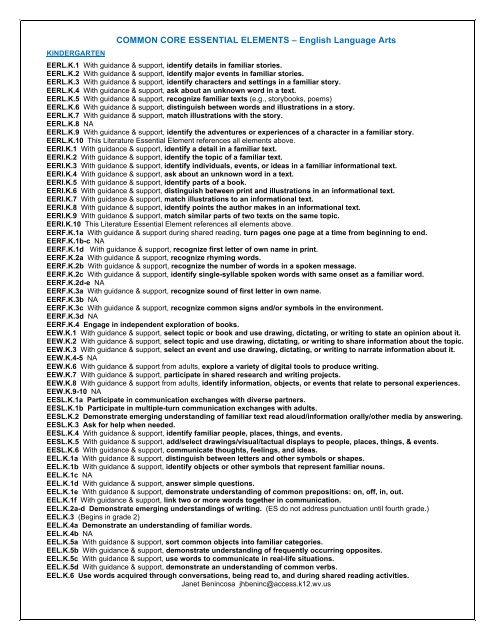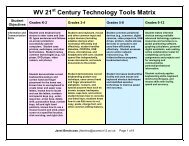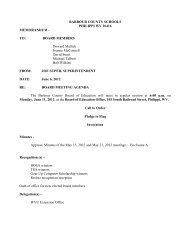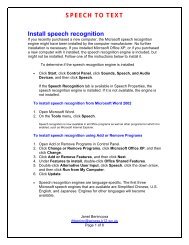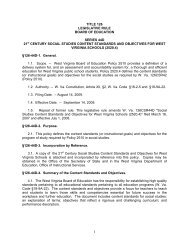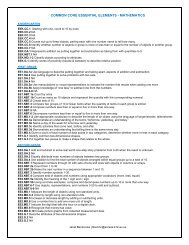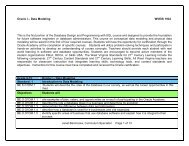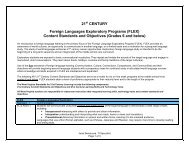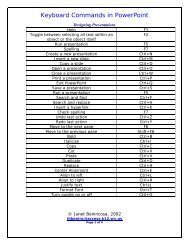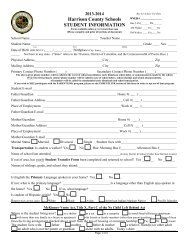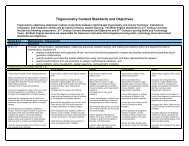CommonCore Essential Elements - ELA
CommonCore Essential Elements - ELA
CommonCore Essential Elements - ELA
You also want an ePaper? Increase the reach of your titles
YUMPU automatically turns print PDFs into web optimized ePapers that Google loves.
KINDERGARTENCOMMON CORE ESSENTIAL ELEMENTS – English Language ArtsEERL.K.1 With guidance & support, identify details in familiar stories.EERL.K.2 With guidance & support, identify major events in familiar stories.EERL.K.3 With guidance & support, identify characters and settings in a familiar story.EERL.K.4 With guidance & support, ask about an unknown word in a text.EERL.K.5 With guidance & support, recognize familiar texts (e.g., storybooks, poems)EERL.K.6 With guidance & support, distinguish between words and illustrations in a story.EERL.K.7 With guidance & support, match illustrations with the story.EERL.K.8 NAEERL.K.9 With guidance & support, identify the adventures or experiences of a character in a familiar story.EERL.K.10 This Literature <strong>Essential</strong> Element references all elements above.EERI.K.1 With guidance & support, identify a detail in a familiar text.EERI.K.2 With guidance & support, identify the topic of a familiar text.EERI.K.3 With guidance & support, identify individuals, events, or ideas in a familiar informational text.EERI.K.4 With guidance & support, ask about an unknown word in a text.EERI.K.5 With guidance & support, identify parts of a book.EERI.K.6 With guidance & support, distinguish between print and illustrations in an informational text.EERI.K.7 With guidance & support, match illustrations to an informational text.EERI.K.8 With guidance & support, identify points the author makes in an informational text.EERI.K.9 With guidance & support, match similar parts of two texts on the same topic.EERI.K.10 This Literature <strong>Essential</strong> Element references all elements above.EERF.K.1a With guidance & support during shared reading, turn pages one page at a time from beginning to end.EERF.K.1b-c NAEERF.K.1d With guidance & support, recognize first letter of own name in print.EERF.K.2a With guidance & support, recognize rhyming words.EERF.K.2b With guidance & support, recognize the number of words in a spoken message.EERF.K.2c With guidance & support, identify single-syllable spoken words with same onset as a familiar word.EERF.K.2d-e NAEERF.K.3a With guidance & support, recognize sound of first letter in own name.EERF.K.3b NAEERF.K.3c With guidance & support, recognize common signs and/or symbols in the environment.EERF.K.3d NAEERF.K.4 Engage in independent exploration of books.EEW.K.1 With guidance & support, select topic or book and use drawing, dictating, or writing to state an opinion about it.EEW.K.2 With guidance & support, select topic and use drawing, dictating, or writing to share information about the topic.EEW.K.3 With guidance & support, select an event and use drawing, dictating, or writing to narrate information about it.EEW.K.4-5 NAEEW.K.6 With guidance & support from adults, explore a variety of digital tools to produce writing.EEW.K.7 With guidance & support, participate in shared research and writing projects.EEW.K.8 With guidance & support from adults, identify information, objects, or events that relate to personal experiences.EEW.K.9-10 NAEESL.K.1a Participate in communication exchanges with diverse partners.EESL.K.1b Participate in multiple-turn communication exchanges with adults.EESL.K.2 Demonstrate emerging understanding of familiar text read aloud/information orally/other media by answering.EESL.K.3 Ask for help when needed.EESL.K.4 With guidance & support, identify familiar people, places, things, and events.EESL.K.5 With guidance & support, add/select drawings/visual/tactual displays to people, places, things, & events.EESL.K.6 With guidance & support, communicate thoughts, feelings, and ideas.EEL.K.1a With guidance & support, distinguish between letters and other symbols or shapes.EEL.K.1b With guidance & support, identify objects or other symbols that represent familiar nouns.EEL.K.1c NAEEL.K.1d With guidance & support, answer simple questions.EEL.K.1e With guidance & support, demonstrate understanding of common prepositions: on, off, in, out.EEL.K.1f With guidance & support, link two or more words together in communication.EEL.K.2a-d Demonstrate emerging understandings of writing. (ES do not address punctuation until fourth grade.)EEL.K.3 (Begins in grade 2)EEL.K.4a Demonstrate an understanding of familiar words.EEL.K.4b NAEEL.K.5a With guidance & support, sort common objects into familiar categories.EEL.K.5b With guidance & support, demonstrate understanding of frequently occurring opposites.EEL.K.5c With guidance & support, use words to communicate in real-life situations.EEL.K.5d With guidance & support, demonstrate an understanding of common verbs.EEL.K.6 Use words acquired through conversations, being read to, and during shared reading activities.Janet Benincosa jhbeninc@access.k12.wv.us
SECOND GRADECOMMON CORE ESSENTIAL ELEMENTS – English Language ArtsEERL.2.1 Answer who and where questions to demonstrate understanding of details in a familiar text.EERL.2.2 Retell familiar stories from diverse cultures, including two or more elements from different parts of the story.EERL.2.3 Identify the actions and feelings of the characters in a familiar story.EERL.2.4 Identify rhyming words or repeated phrases in a familiar story, poem, or song.EERL.2.5 Determine the beginning and ending of a story.EERL.2.6 Identify the speakers in a dialogue.EERL.2.7 Use illustrations in print or digital text to identify characters and settings.EERL.2.8 NAEERL.2.9 Identify similarities in two versions of the same story.EERL.2.10 This Literature <strong>Essential</strong> Element references all elements above.EERI.2.1 Answer who and what questions to demonstrate understanding of details in a familiar text.EERI.2.2 Identify the topic of the text.EERI.2.3 Sequence at least two steps in a procedure or ideas/incidents n an event.EERI.2.4 Identify words related to a topic of a text.EERI.2.5 Locate facts or information in a familiar text.EERI.2.6 Identify purpose of a text.EERI.2.7 Demonstrate understanding of how images relate to a familiar informational text.EERI.2.8 NAEERI.2.9 Identify a common element between two texts.EERI.2.10 This Informational Text <strong>Essential</strong> Element references all elements above.EERF.2.3a-c Apply letter-sound & word analysis skills decoding words. In context, identify 18 or moreEERF.2.3d-e Identify the beginning sound of familiar words beginning with a single consonant sound.EERF.2.3f Recognize 10 or more written words.EERF.2.4 Read a shared-reading selection. (The ES does not address fluency, but does address listening.)EEW.2.1 Select a book and write, draw, or dictate to state an opinion about it & one reason to support the opinion.EEW.2.2 Select a topic and use drawing, dictating, or writing to compose a message with one fact about the topic.EEW.2.3 Select an event or personal experience and use drawing, writing, or dictating to compose a message about it.EEW.2.4 (Begins in grade 3)EEW.2.5 With guidance & support from adults & peers, add more information to own drawing, dictating, or writing.EEW.2.6 With guidance & support from adults & peers, use technology to produce and publish writing.EEW.2.7 Participate in shared writing projects – communicate a message to add information.EEW.2.8 Identify information related to personal experiences and answer simple questions about those experiences.EEW.2.9-EEW.2.10 (Begins in grade 4)- (Begins in grade 3)EESL.2.1a Engage in multiple-turn exchanges with peers and adults in small groups.EESL.2.1b Build on comments or topics initiated by adults and peers.EESL.2.1c Ask questions related to a prescribed topic or text.EESL.2.2 Ask & answer questions about key details from text or information presented orally or through other media.EESL.2.3 Answer questions about what a speaker says.EESL.2.4 Identify a photograph or object that reflects a personal experience and tell one detail about it.EESL.2.5 Select a visual, audio, or tactual representation to depict an experience, thoughts, or feelings.EESL.2.6 Communicate to provide clarification.EEL.2.1a Produce all letters.EEL.2.1b Use frequently occurring nouns.EEL.2.1c Use frequently occurring pronouns to refer to self and others.EEL.2.1d Use frequently occurring verbs.EEL.2.1e Use frequently occurring adjectives.EEL.2.1f Link two or more words together in communication.EEL.2.2 Capitalize the first letter of familiar names.EEL.2.2b-c NAEEL.2.2d Identify printed rhyming words with the same spelling pattern.EEL.2.2e Consult print in the environment to support reading and spelling.EEL.2.3 Use informal language when communicating.EEL.2.4a-b Use newly acquired vocabulary.EEL.2.4c Sort words into familiar categories.EEL.2.4d NAEEL.2.4e Ask about an unknown word.EEL.2.5a Identify real-life connections between words and their use.EEL.2.5b Identify the function of common nouns.EEL.2.6 Use adjectives and adverbs from texts that have been read.Janet Benincosa jhbeninc@access.k12.wv.us
THIRD GRADECOMMON CORE ESSENTIAL ELEMENTS – English Language ArtsEERL.3.1 Answer questions to demonstrate understanding of text.EERL.3.2 Retell stories, including fables, folktales, and myths from diverse cultures including details from the text.EERL.3.3 Identify the traits, motivations, or feelings of characters in a story.EERL.3.4 Determine whether something described in the text could be true.EERL.3.5 Determine the beginning, middle, and end of a story.EERL.3.6 Identify personal point of view about a character or the narrator.EERL.3.7 Identify parts of illustrations that depict a particular mood, setting, or character.EERL.3.8 NAEERL.3.9 Identify similarities in the settings of two stories by the same author.EERL.3.10 This Literature <strong>Essential</strong> Element references all elements above.EERI.3.a Answer questions related to a familiar text.EERI.3.2 Identify a detail of a text.EERI.3.3 List the progression of a series of events.EERI.3.4 Determine the meaning of vocabulary related to a familiar text.EERI.3.5 Identify text features and search tools.EERI.3.6 Identify a personal point of view about a text.EERI.3.7 Demonstrate an understanding of text by connecting a visual element.EERI.3.8 NAEERI.3.9 Identify similarities of two resources on the same topic.EERI.3.10 This Informational Text <strong>Essential</strong> Element references all elements above.EERF.3.3a In context, demonstrate basic knowledge of letter-sound correspondences.EERF.3.3b With models & supports, decode single-syllable words-common spelling patterns/high-frequency rhymes.EERF.3.3c NAEERF.3.3d Recognize 40 or more written words.EERF.3.4a Read familiar text with purpose and understanding.EERF.3.4b NAEERF.3.4c Use context to determine missing words in familiar texts.EEW.3.1a-b Select a text and write to state an opinion about it and one reason to support the opinion.EEW.3.1c-d NAEEW.3.2a-b Select a topic and write about it including one fact or detail.EEW.3.2c-d NAEEW.3.3a Select an event or personal experience and write one thing about it.EEW.3.3b-d NAEEW.3.4 With guidance & support, produce writing that expresses more than one idea.EEW.3.5 With guidance & support from adults & peers, revise own writing by adding more information.EEW.3.6 With guidance & support from adults, use technology to produce writing while interacting and collaborating.EEW.3.7 Gather information about a topic for a group research project.EEW.3.8 Sort information into two provided categories and write information learned about them.EEW.3.9 ((Begins in grade 4)EEW.3.10 Write routinely for a variety of tasks, purposes, and audiences.EESL.3.1a Engage in collaborative interactions about texts.EESL.3.1b Listen to others’ ideas before responding.EESL.3.1c Ask questions that link to ideas of others.EESL.3.1c Ask questions that link to ideas of others.EESL.3.1d Express ideas clearly.EESL.3.2 Ask & answer questions about details from text read aloud/information presented orally/other media.EESL.3.3 Ask & answer questions about what speaker says.EESL.3.4 Recount a personal experience including details.EESL.3.5 Create a multimedia presentation of a story or poem.EESL.3.6 Combine words for effective communication to clarify thoughts, feelings, and ideas.EEL.3.1a Use noun+verb, noun+adjective, & subject+verb+object combinations in communication.EEL.3.1b Use plural nouns.EEL.3.1c NAEEL.3.1d Use present and past tense verbs.EEL.3.1e-g NAEEL.3.1h Produce utterances using three or more words.EEL.3.1i Ask simple questions.EEL.3.2a Capitalize the first letter of a familiar place.EEL.3.2b-d NAEEL.3.2e Spell common high-frequently words accurately.EEL.3.2f Use spelling patterns in familiar words with common spelling patterns to spell words with same pattern.EEL.3.2g Consult print in the environment to support reading and spelling.EEL.3.3a Use language to make simple requests.EEL.3.3b Use language to comment or share information.EEL.3.4a NAEEL.3.4b Identify temporal meaning of words when common affixes (-ing, -ed) are added to common verbs.EEL.3.4c-d NAEEL.3.5a NAEEL.3.5b Identify real-life connections between words and their use.EEL.3.5c Identify words that describe personal emotional states.EEL.3.6 Demonstrate understanding of words that signal spatial and temporal relationships.Janet Benincosa jhbeninc@access.k12.wv.us
COMMON CORE ESSENTIAL ELEMENTS – English Language ArtsFOURTH GRADEEERL.4.1 Use details from the text to recount what the text says.EERL.4.2 Determine the main idea of a text.EERL.4.3 Use details from text to describe a character in a story.EERL.4.4 Determine meaning of words in context.EERL.4.5 Recognize a text as a story or poem.EERL.4.6 Identify the narrator of a story.EERL.4.7 Make connections between text and visual or oral presentations.EERL.4.8 NAEERL.4.9 Compare and contrast two stories, myths, or texts from different cultures.EERL.4.10 This Literature <strong>Essential</strong> Element references all elements above.EERI.4.1 Use details from the text to recount what the text says.EERI.4.2 Determine a main idea of a text.EERI.4.3 Use details from text to describe what happened.EERI.4.4 Determine meaning of words in context.EERI.4.5 Identify the chronological structure of a text.EERI.4.6 Identify a firsthand account of an event.EERI.4.7 Interpret information presented visually and orally.EERI.4.8 Identify the author’s point.EERI.4.9 Identify similarities of two resources on the same topic.EERI.4.10 This Informational Text <strong>Essential</strong> Element references all elements above.EERF.4.3a Apply letter-sound knowledge to use first letter plus context to identify unfamiliar words.EERF.4.3b Decode single-syllable words with common spelling patterns.EERF.4.4 Read text comprised of familiar words with accuracy and understanding.EEW.4.1a Select topic or text and write an opinion about it.EEW.4.1b-c List reasons to support the opinion.EEW.4.d NAEEW.4.2a Select a topic and related visual, tactual, or multimedia information.EEW.4.2b List words, facts, or details related to the topic.EEW.4.2c-e NAEEW.4.3a Write about two events in sequence related to a personal experience.EEW.4.3b List words that describe an event or personal experience to use when writing about it.EEW.4.3c-e NAEEW.4.4 Produce writing that expresses more than one idea with a logical organization.EEW.4.5 With guidance & support from adults & peers, plan by brainstorming & revise own writing by adding more information.EEW.4.6 With guidance & support from adults, use technology to produce writing while interacting & collaborating with others.EEW.4.7 Gather information about a topic from two or more sources for a group research project.EEW.4.8 Recall information from personal experiences and sort into provided categories.EEW.4.9a-b Apply <strong>Essential</strong> <strong>Elements</strong> of Grade 4 Reading Standards to literature and to informational text.EEW.4.10 Write routinely for a variety of tasks, purposes, and audiences.EESL.4.1a Contribute ideas from prior knowledge and experience during discussions about text.EESL.4.1b Take turns in discussions with others.EESL.4.1c Ask and answer questions about information presented by others.EESL.4.1d Identify the key ideas of the discussion.EESL.4.2 Identify the main idea of a text presented through diverse media.EESL.4.3 Identify a point the speaker makes.EESL.4.4 Tell a story about a personal experience with supporting details.EESL.4.5 Add audio recordings or visuals to a presentation about a personally relevant topic.EESL.4.6 Differentiate between communication partners and contexts that call for formal and informal communication.EEL.4.1a Use possessive pronouns.EEL.4.1b-c NAEEL.4.1d Use comparative and superlative adjectives to describe people or objects.EEL.4.1e Use common prepositions.EEL.4.1f Communicate using grammatically complete utterances.EEL.4.2a Capitalize the first word in a sentence.EEL.4.2b-c NAEEL.4.2d Spell words phonetically, drawing on knowledge of letter-sound relationships, and/or common spelling patterns.EEL.4.3a Use language to express emotion.EEL.4.3b NAEEL.4.3c Communicate effectively with peers and adults.EEL.4.4a Use context as a clue to guide selection of a word that completes a sentence read aloud by an adult.EEL.4.4b Use frequently occurring root words & the words that result when word endings are added.EEL.4.4c NAEEL.4.5a NAEEL.4.5b Use common idioms.EEL.4.5c Demonstrate understanding of opposites.EEL.4.6 Use domain-specific words.Janet Benincosa jhbeninc@access.k12.wv.us
COMMON CORE ESSENTIAL ELEMENTS – English Language ArtsFIFTH GRADEEERL.5.1 Identify words in the text to answer a question about explicit information.EERL.5.2 Identify the central idea or theme of a familiar story, drama, or poem.EERL.5.3 Compare and contrast two characters in a familiar story.EERL.5.4 After listening to or reading a familiar text, determine the meanings of words or phrases.EERL.5.5 Identify the beginning, middle, and end of a poem, drama, or story with a clear sequential structure.EERL.5.6 Determine the point of view of the narrator.EERL.5.7 Identify illustrations and multimedia elements that add to understanding of a text.EERL.5.8 NAEERL.5.9 Compare two stories with similar topics.EERL.5.10 This Literature <strong>Essential</strong> Element references all elements above.EERI.5.1 Select words or phrases from the text to support inferences.EERI.5.2 When given text, identify the main ideas that are supported by the key details.EERI.5.3 Make connections between two individuals or events/actions in a text.EERI.5.4 After listening to or reading a text, determine the meanings of domain-specific words and phrases.EERI.5.5 Identify the beginning, middle, and end of a text with a clear sequential structure.EERI.5.6 Given two pieces of information on the same event or topic, note what is the same.EERI.5.7 Use print or digital sources for information to answer a question.EERI.5.8 Identify the evidence or reasons the author uses to support points in text.EERi.5.9 Collect information from tow or more texts on the same topic to share information about a subject.EERI.5.10 This Informational Text <strong>Essential</strong> Element references all elements above.EERF.5.3a Decode two-syllable words.EERF.5.3b Read more than 20 common high-frequency words.EERF.5.4 Read text comprised of familiar words with accuracy and understanding.EEW.5.1a Introduce a topic or text and state an opinion about it.EEW.5.1b Provide reasons to support the opinion.EEW.5.1c-d NAEEW.5.2a Introduce a topic and organize illustrations or other multimedia related to it.EEW.5.2b Provide facts, details, or other information related to the topic.EEW.5.2c-e NAEEW.5.3a-b Introduce the experience or situation, and follow with three or more events in sequence.EEW.5.3e NAEEW.5.4 Produce writing that is appropriate to task, purpose, and audience.EEW.5.5 With guidance & support from peers & adults, plan by brainstorming & revise own writing by adding more information.EEW.5.6 With guidance & support from adults, use technology to produce writing while interacting & collaborating with others.EEW.5.7 Conduct short research projects using two or more sources.EEW.5.8 Recall information from personal experiences or gather relevant information from print and digital sources.EEW.5.9a Apply <strong>Essential</strong> <strong>Elements</strong> of Grade 5 Reading Standards to literature.EEW.5.9b Apply <strong>Essential</strong> <strong>Elements</strong> of Grade 5 Reading Standards to informational text.EEW.5.10 Write routinely for a variety of tasks, purposes, and audiences.EESL.5.1a Prepare for discussions.EESL.5.1b Engage in discussions to share information on the topic.EESL.5.1c Communicate directly with peers in multi-turn exchanges.EESL.5.1d Ask and answer questions of adult or peer communication partners to identify key issues of the discussion.EESL.5.2 Identify the main idea and supporting details of a text presented through diverse media.EESL.5.3 Identify the main point a speaker makes.EESL.5.4 Create a simple report or presentation about a curriculum-based topic.EESL.5.5 Select or create audio recording, images, photographs, or other visuals/tactual displays to enhance a presentation.EESL.5.6 Use formal and informal language.EEL.5.1a Use singular and plural nouns with matching verbs.EEL.5.1b-d NAEEL.5.1e Use frequently occurring conjunctions: and, but, or, for, because.EEL.5.2a Capitalize names and the first word in a sentence.EEL.5.2b Use a period to mark the end of a sentence.EEL.5.2c-d NAEEL.5.2e Spell untaught word phonetically, drawing on letter-sound relationships and common spelling patterns.EEL.5.3 Use language to achieve desired meaning when communicating.EEL.5.4a Use context as a clue to determine the meaning of words.EEL.5.4b Identify the temporal meaning of words when common affixes are added to common nouns and verbs.EEL.5.5 Demonstrate understanding of word relationships (Use simple, common idioms)EEL.5.6 Use domain-specific words (e.g., if, then, next)Janet Benincosa jhbeninc@access.k12.wv.us
COMMON CORE ESSENTIAL ELEMENTS - English Language ArtsSIXTH GRADEEERL.6.1 Determine what a text says explicitly as well as what simple inferences should be drawn.EERL.6.2 Determine the theme or central idea of a familiar story and identify details that relate to it.EERL.6.3 Identify the episodes or significant events in a story or drama.EERL.6 4 Determine the meaning of simple idioms and figures of speech as they are used in a text.EERL.6 5 Determine how a sentence, paragraph, scene, or stanza fits into the overall structure of the text.EERL.6.6 Use an example from a text to describe the point of view of the narrator.EERL.6.7 Compare a text version of a story, drama, or poem with an audio, video, or live version of the text.EERL.6-8 NAEERL.6.9 (See EERL.6.7)EERL.6.10 This Literature <strong>Essential</strong> Element references all elements above.EERI.6.1 Analyze a text to determine what is says explicitly as well as what inferences should be drawn.EERI.6.2 Determine the central idea of a short passage and details or facts related to it.EERI.6.3 Identify the progression of a key individual, event, or idea throughout an informational text.EERI.6.4 Determine the meaning of simple idioms and figures of speech as they are used in a text.EERI.6.5 Describe how an element of the text fits into the overall structure of the text.EERI.6.6 Use an example from text to describe the author’s purpose or point of view.EERI.6.7 Integrate information from different media and formats of texts.EERI.6.8 Distinguish claims in a text supported by reason.EERI.6.9 (See EERI.6.7)EERI.6.10 This Informational Text <strong>Essential</strong> Element references all elements above.EEW.6.1a-b With guidance & support, write a claim & support it with reasons.EEW.6.1c-e NAEEW.6.2a-b Write to convey ideas and information, including facts, details, and other information.EEW.6.3a-b Introduce the experience or situation, at least one character, and two or more events in sequence.EEW.6.4 Produce writing that is appropriate for the task, purpose, or audience.EEW.6.5 With guidance & support from adults & peers, plan by brainstorming & revise own writing by adding information.EEW.6.6 Use technology to produce writing while interacting and collaborating with others.EEW.6.7 Conduct research to answer a question based on two or more sources of information.EEW.6.8 Identify quotes from print or digital sources that provide information about a topic.EEW.6.9a-b Apply <strong>Essential</strong> <strong>Elements</strong> of Grade 6 Reading Standards to literature and to informational text.EESL.6.1a prepare for discussion through prior study.EESL.6.1b With guidance & support from adults & peers, follow simple, agreed-upon rules for discussions & contribute.EESL.6.1c Ask & answer questions specific to the topic, text, or issue under discussion.EESL.6.1d Restate key ideas expressed in the discussion.EESL.6.2 Identify information presented in graphical, oral, visual, or multimodal formats that relates to a topic or text.EESL.6.3 Identify points the speaker makes to support an argument or claim.EESL.6.4 Present findings including descriptions, facts, or details related to a topic.EESL.6.5 Select an auditory, visual, or tactual display to clarify the information in presentations.EESL.6.6 Use formal and informal language as appropriate to the communication partner and situation.EEL.6.1 Use personal pronouns (e.g., he, she, they) correctly.EEL.6.2a Use question marks at the end of written questions.EEL.6.2b Spell untaught words phonetically, drawing on letter-sound relationships and common spelling patterns.EEL.6.3 Use language to achieve desired meaning in communication.EEL.6.4a Use context to identify which word in an array of content-related words is missing from a sentence.EEL.6.4b NAEEL.6.4c Seek clarification & meaning support when unfamiliar words are encountered while reading or communicating.EEL.6.4d NAEEL.6.5 Demonstrate word relationships. (Interpret similes)EEL.6.6 Use general academic and domain-specific words and phrases.Janet Benincosa jhbeninc@access.k12.wv.us
COMMON CORE ESSENTIAL ELEMENTS - English Language ArtsSEVENTH GRADEEERL.7.1 Cite text to draw inferences from stories and poems.EERL.7.2 Determine the theme or central idea of a text and identify the details that relate to it.EERL.7.3 Recognize the relationship of two story elements.EERL.7.4 Use rhyme & other repetitions to support understanding of a poem or a section of a story or drama.EERL.7.5 Determine how poetry form and structure contributes to its meaning.EERL.7.6 Identify how a character’s point of view is the same or different from another character.EERL.7.7 Compare video version of story, poem, or drama to text-based version of same story, poem, or drama.EERL.7.8 NAEERL.7.9 Recognize the difference between fictional characters and nonfictional characters.EERL.7.10 This <strong>Essential</strong> Element references all elements above.EERI.7.1 Cite text to draw inferences from informational text.EERI.7.2 Determine two central ideas that progress throughout the text.EERI.7.3 Identify interactions between individuals, events, or ideas in text.EERI.7.4 Determine the meaning of words and phrases as they are used in an informational text.EERI.7.5 Determine how headings, key words, and key phrases relate to the topic of a text.EERI.7.6 Determine author’s point of view and compare to own point of view.EERI.7.7 Compare the experience of reading a text to listening or watching a video of the same text.EERI.7.8 Delineate the specific claims for text.EERI.7.9 Compare information provided by authors of two different texts on the same topic.EERI.7.10 This <strong>Essential</strong> Element references all elements above.EEW.7.1 Write a claim and support it with reasons or other relevant evidence.EEW.7.2a-b Write to convey ideas & information (facts, details, & other information) & graphics & multimedia as needed.EEW.7.2c NAEEW.7.2d Use domain-specific vocabulary when writing about a topic.EEW.7.2e-f NAEEW.7.3 Select event or personal experience & write about it (at least one character & two or more events in sequence).EEW.7.4 Produce writing that is appropriate for the task, purpose, or audience.EEW.7.5 With guidance & support from adults & peers, plan by brainstorming & revise own writing by adding information.EEW.7.6 Use technology, including the Internet, to produce writing to interact and collaborate with others.EEW.7.7 Conduct research to answer a question based on multiple sources of information.EEW.7.8 Select quotes from multiple print or digital sources that provides important information about a topic.EEW.7.9 Use information from literary and informational text to support writing.EEW.7.10 Write routinely for a variety of tasks, purposes, and audiences.EESL.7.1a Com to discussions prepared to share information.EESL..7.1b With guidance & support from adults & peers, follow rules for discussions & carry out assigned roles.EESL.7.1c Remain on topic of discussion when asking or answering questions or making other contributions.EESL.7.1d Accept when others involved in the discussion agree or disagree with own perspective.EESL.7.2 Identify the main idea of information presented in graphical, oral, visual or multimodal formats.EESL.7.3 Determine whether the claims made by a speaker are fact or opinion.EESL.7.4 Present findings including descriptions, facts, or details related to a main idea or theme.EESL.7.5 Select or create audio recording, images, photographs, or other visual/tactual displays in presentations.EESL.7.6 Communicate precisely or efficiently as required by the context, task, and communication partner.EEL.7.1 Produce simple complete sentences when writing or communicating.EEL.7.2a Use end punctuation when writing a sentence or question.EEL.7.2b Spell words phonetically, drawing on knowledge of letter-sound relationships / common spelling patterns.EEL.7.3 Use language to achieve desired meaning when writing or communicating.EEL.7.4a Use context to identify which word in an array of content-related words is missing from a sentence.EEL.7.4b NAEEL.7.4c Seek clarification & meaning support when unfamiliar words are encountered reading or communicating.EEL.7.4d NAEEL.7.5 Demonstrate understanding of synonyms and antonyms.EEL.7.6 Use general academic and domain-specific words and phrases.Janet Benincosa jhbeninc@access.k12.wv.us
EIGHTH GRADECOMMON CORE ESSENTIAL ELEMENTS - English Language ArtsEERL.8.1 Cite text to support inferences from stories and poems.EERL.8.2 Provide a summary of a familiar text.EERL.8.3 Identify which incidents in a story or drama lead to subsequent action.EERL.8.4 Determine meanings of words and phrases in literature including figurative language.EERL.8.5 Compare and contrast the structure of two or more texts.EERL.8.6 Determine difference in points of view of character & audience or reader in a text with suspense or humor.EERL.8.7 Compare and contrast a scene from a filmed or live production of a story or drama to the text or script.EERL.8.8 NAEERL.8.9 Compare and contrast themes, patterns of events, or characters across two or more stories or dramas.EERL.8.10 This <strong>Essential</strong> Element references all elements above.EERI.8.1 Cite text to support inferences from informational text.EERI.8.2 provide a summary of a familiar informational text.EERI.8.3 Make connections between key individuals or events in a text.EERI.8.4 Determine meanings of words and phrases in informational text including figurative language.EERI.8.5 Determine the role of sentences in a paragraph.EERI.8.6 Determine an author’s purpose or point of view.EERI.8.7 Select medium based on advantages/disadvantages of using print, digital text, video, or multimedia to present.EERI.8.8 Determine whether claims in a text are fact or opinion.EERI.8.9 Compare and contrast the key information in two different texts on the same topic.EERI.8.10 This <strong>Essential</strong> Element references all elements above.EEW.8.1 Write an argument to support claims with one clear reason or piece of evidence.EEW.8.2 Write to convey ideas & information clearly (facts, details, & other information / graphics & multimedia)EEW.8.3 Introduce an event or personal experience, at least one character & two or more events in sequence.EEW.8.4 Produce writing that is appropriate for the task, purpose, or audience.EEW.8.5 With guidance & support from adults & peers, plan by brainstorming & revise own writing by adding information.EEW.8.6 Use technology, including Internet, to produce writing to interact and collaborate with others.EEW.8.7 Conduct short research projects to answer and pose questions based on one source of information.EEW.8.8 Select quotes from multiple print or digital sources that provide important information about a topic.EEW.8.9 Use information from literary and informational text to support writing.EEW.8.10 Write routinely for a variety of tasks, purposes, and audiences.EESL.8.1a Come to discussions prepared to share information previously studiedEESL.8.1b Follow simple rules and carry out assigned roles during discussions.EESL.8.1c-d Respond to others’ questions and comments by answering questions regarding content.EESL.8.2 Describe the purpose of information presented in graphical, oral, visual, or multimodal formats.EESL.8.3 Determine whether claims in an oral presentation are fact or opinion.EESL.8.4 Present findings including relevant details.EESL.8.5 Integrate multimedia and visual information into presentations.EESL.8.6 Adapt communication to variety of contexts & tasks using complete sentences when appropriate.EESL.8.7a NAEESL.8.7b Form and use the simple verb tenses.EESL.8.7c NAEESL.8.7d Use appropriate verbs to match nouns.EESL.8.2a Use end punctuation and capitalization when writing a sentence or question.EESL.8.2b NAEESL.8.2c Spell words phonetically, drawing on knowledge of letter-sound relationships/common spelling patterns.EESL.8.3 Use to-be verbs accurately when writing and communicating (am, are, is, was, were, be, become, became).EESL.8.4a Use context to identify which word in an array of content-related words is missing from a sentence.EESL.8.4b NAEESL.8.4c Seek clarification & meaning support when unfamiliar words encountered while reading or communicating.EESL.8.4d NAEESL.8.5a Demonstrate understanding of the use of multiple meaning words.EESL.8.5b Use knowledge of common words to understand meaning of compound & complex words.EESL.8.5c Use descriptive words to add meaning when writing and communicating.EESL.8.6 Acquire and use general academic and domain-specific words and phrases.Janet Benincosa jhbeninc@access.k12.wv.us
COMMON CORE ESSENTIAL ELEMENTS - English Language ArtsNinth-Tenth GradeEERL.9-10.1 Determine which citations demonstrate what the text says explicitly & inferences drawn from text.EERL.9-10.2 Determine central idea of the text and select details that relate to it; recount the text.EERL.9-10.3 Describe interactions between characters.EERL.9-10.4 Determine meaning of words & phrases as used in a text (common analogies & figures of speech).EERL.9-10.5 Determine the sequence of events in a story or drama.EERL.9-10.6 Connect experiences of characters in a story or drama from outside U.S. with personal experience.EERL.9-10.7 Compare the representation of a subject or topic in two different artistic mediums.EERL.9-10.8 NAEERL.9-10.9 Identify when an author references one text to another text.EERL.9-10.10 This <strong>Essential</strong> Element references all elements above.EERI.9-10.1 Determine which citations demonstrate what text says explicitly as well as inferentially.EERI.9-10.2 Determine the central idea of the text and select details to support it.EERI.9-10.3 Determine connections drawn between ideas or events in informational text.EERI.9-10.4 Determine meanings of words and phrases in informational text including figurative language.EERI.9-10.5 Determine which sentences in a text support the claims of the author.EERI.9-10.6 Determine an author’s purpose or point of view.EERI.9-10.7 Compare a selection of informational text about a person with another medium.EERI.9-10.8 Delineate statements that support an argument.EERI.9-10.9 Make connections between U.S. documents of historical & literary significance.EERI.9-10.10 This Literature <strong>Essential</strong> Element references all elements above.EEW.9-10.1 Write about a personal opinion and give more than one reason supporting & rejecting the claim.EEW.9-10.2 Write to convey ideas & information using clear organization (facts, details, graphics, multimedia).EEW.9-10.3 Introduce an experience or situation (at least one character & describe multiple events in sequence).EEW.9-10.4 Produce writing that is appropriate to a particular task, purpose, and audience.EEW.9-10.5 Develop writing by planning and revising own writing by adding more information.EEW.9-10.6 Use technology, including Internet, to produce, publish, & update individual or shared writing products.EEW.9-10.7 Conduct short research projects to answer questions posed by self and others using multiple sources.EEW.9-10.8 Select information from multiple sources and use information to write answers to research questions.EEW.9-10.9a Apply <strong>Essential</strong> <strong>Elements</strong> of Grade 9-10 Reading Standards to literature.EEW.9-10.9b Apply <strong>Essential</strong> <strong>Elements</strong> of Grade 9-10 Reading Standards to informational text.EEW.9-10.10 Write routinely over time for a range of tasks, purposes, and audiences.EESL.9-10.1a Prepare for discussions by collecting information on the topic.EESL.9-10.1b Work with peers to set rules for discussions.EESL.9-10.1c Ask and answer questions during a discussion.EESL.9-10.1d Indicate agreement or disagreement with others during discussions.EESL.9-10.2 Determine the credibility of information presented in diverse media or formats.EESL.9-10.3 Determine whether a claim made by a speaker is credible.EESL.9-10.4 Present information logically with an organization that is appropriate to purpose, audience, and task.EESL.9-10.5 Use digital media in presentations to support understanding.EESL.9-10.6 Adapt communication to a variety of contexts and tasks using complete sentences when appropriate.EEL.9-10.1a-b NA - Use a variety of parts of speech in writing or communication to convey information.EEL.9-10.2a Use correct punctuation when writing.EEL.9-10.2c Spell most single-syllable words correctly & apply knowledge of word chunks in spelling longer words.EEL.9-10.3 Write and revise work so that it communicates clearly to the intended audience.EEL.9-10.4a-b Use context to determine the meaning of unknown words. - NAEEL.9-10.4c Consult reference materials to clarify the meaning of unfamiliar words encountered when reading.EEL.9-10.5 Distinguish understanding of multiple meaning of words and figures of speech.EEL.9-10.6 Acquire and use general academic and domain-specific words and phrases.Janet Benincosa jhbeninc@access.k12.wv.us
COMMON CORE ESSENTIAL ELEMENTS - English Language ArtsEleventh-Twelfth GradeEERL.11-12.1 Cite textual evidence to determine where the text leaves matters uncertain.EERL.11-12.2 Provide a summary of an unfamiliar text.EERL.11-12.3 Explain how characters develop over the course of a story.EERL.11-12.4 Determine how words or phrases with multiple meanings have an impact on meaning or tone of a text.EERL.11-12.5 Determine how the author’s choice of where to end the story contributes to the meaning.EERL.11-12.6 Identify the intended meaning to match what an author wrote.EERL.11-12.7 Compare two or more interpretations of a story, drama, or poem.EERL.11-12.8 NAEERL.11-12.9 Compare and contrast elements of American literature to other literary works, self, or one’s world.EERL.11-12.10 This Literature <strong>Essential</strong> Element references all elements above.EERI.11-12.1 Cite textual evidence to determine where informational text leaves matters uncertain.EERI.11-12.2 Provide a summary of an informational text.EERI.11-12.3 Explain how specific events develop over the course of the text.EERI.11-12.4 Determine the meaning of words or phrases within an informational text.EERI.11-12.5 Determine how the author’s choice of where to make an argument contributes to the meaning.EERI.11-12.6 Determine how the author’s style affects the purpose of the text.EERI.11-12.7 Analyze information presented in different media on related topics to answer questions or solve problems.EERI.11-12.8 Explain how U.S. texts inform citizens’ rights.EERI.11-12.9 Determine the purposes of foundational U.S. documents of historical significance.EERI.11-12.10 This <strong>Essential</strong> Element references all elements above.EEW.11-12.1 Write to express an opinion with supporting information about a topic or text and a concluding statement.EEW.11-12.2 Write to convey ideas & information using clear organization & including facts, details, graphics, & multimedia.EEW.11-12.3 Introduce an experience or situation, at least one character & describe multiple events in sequence.EEW.11-12.4 Produce writing that is appropriate to a particular task, purpose, and audience.EEW.11-12.5 Develop and strengthen writing as needed by planning, revising, editing, and rewriting.EEW.11-12.6 Use technology, including the Internet, to produce, publish, & update an individual or shared writing project.EEW.11-12.7 Conduct short research projects to answer questions posed by self and others using multiple sources.EEW.11-12.8 Select information from multiple sources and use the information to write answers to research questions.EEW.11-12.9a Apply Grades 11-12 <strong>Essential</strong> <strong>Elements</strong> for Reading Standards to literature.EEW.11-12.9b Apply Grades 11-12 <strong>Essential</strong> <strong>Elements</strong> for Reading Standards to nonfictional or informational texts.EEW.11-12.10 Write routinely over extended time frames for a range of tasks, purposes, and audiences.EESL.11-12.1a Prepare for discussions by collecting information on the topic.EESL11-12.1b Work with peers to set rules, goals, and deadlines to promote democratic discussions.EESL.11-12.1c Ask and answer questions to verify or clarify own ideas and understandings during a discussion.EESL.11-12.1d Restate comments or claims made by others during a discussion.EESL.11-12.2 Determine the credibility and accuracy of information presented across diverse media or formats.EESL.11-12.3 Determine whether the claims made by a speaker are credible.EESL.11-12.4 Present information & findings (alternative or opposing information) with appropriate organization.EESL.11-12.5 Use digital media in presentations to support understanding.EESL.11-12.6 Adapt communication to a variety of contexts and tasks using complete sentences when appropriate.EEL.11-12.1a Apply understandings that conventions of English are required in some forms of communication.EEL.11-12.1b Use appropriate resources to resolve issues involving grammar usage, punctuation, and spelling.EEL.11-12.2 Apply knowledge of conventions of English grammar to convey desired meaning in writing & communication.EEL.11-12.3 Vary sentence structure using a variety of simple and compound sentence structures.EEL.11-12.4a Use context to determine the meaning of unknown words.EEL.11-12.4b-c NAEEL.11-12.4b-d Consult reference materials to clarify the meaning of unfamiliar words encountered when reading.EEL.11-12.5 Interpret simple figures of speech encountered while reading or listening.EEL.11-12.6 Use academic & domain-specific words & phrases for communication appropriate for student’s goals.Janet Benincosa jhbeninc@access.k12.wv.us


